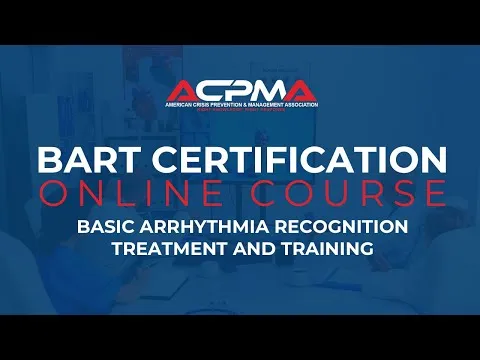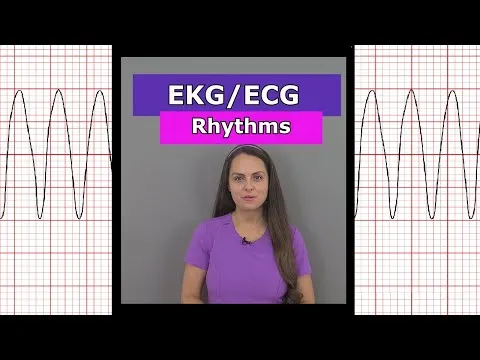
Basic Arrhythmias Sinus Brady Tachy Premature Beats ECG EKG Interpretation (Part 3) 
Join ICU Advantage Academy and earn CE credits while learning about basic arrhythmias in ECG/EKG interpretation. In this course, you will gain a comprehensive understanding of major types of arrhythmias, starting with sinus arrhythmia and moving on to premature beats such as PACs, PJCs, and PVCs. The course also covers basic brady and tachy rhythms like sinus bradycardia, sinus tachycardia, and supraventricular tachycardia (SVT). By the end of the course, you will be able to confidently recognize and interpret these arrhythmias on your patients' rhythm strips. Don't miss out on this opportunity to enhance your skills in critical care nursing. ▼
ADVERTISEMENT
Course Feature
![]() Cost:
Cost:
Free
![]() Provider:
Provider:
Youtube
![]() Certificate:
Certificate:
No Information
![]() Language:
Language:
English
![]() Start Date:
Start Date:
2019-07-22 00:00:00
Course Overview
❗The content presented here is sourced directly from Youtube platform. For comprehensive course details, including enrollment information, simply click on the 'Go to class' link on our website.
Updated in [September 27th, 2023]
We considered the value of this course from many aspects, and finally summarized it for you from two aspects: skills and knowledge, and the people who benefit from it: (Please note that our content is optimized through artificial intelligence tools and carefully reviewed by our editorial staff.) What skills and knowledge will you acquire during this course? During this course on Basic Arrhythmias Sinus Brady Tachy Premature Beats ECG EKG Interpretation (Part 3), learners will acquire the following skills and knowledge: 1. Understanding of the major types of arrhythmias: The course provides an overview of the major types of arrhythmias that learners are likely to come across. This includes sinus arrhythmia, premature atrial contractions (PACs), premature junctional contractions (PJC), premature ventricular contractions (PVCs), sinus bradycardia, sinus tachycardia, and supraventricular tachycardia (SVT). 2. Identification of defining characteristics: Learners will be able to recognize and identify arrhythmias based on their defining characteristics. The course provides examples and explanations for each type of arrhythmia, helping learners understand the specific features that distinguish them. 3. Interpretation of arrhythmias on rhythm strips: By the end of the course, learners will be able to interpret arrhythmias on patients' rhythm strips. They will have the knowledge and skills to analyze the ECG/EKG readings and identify the specific arrhythmia present. Who will benefit from this course? This course on Basic Arrhythmias Sinus Brady Tachy Premature Beats ECG EKG Interpretation (Part 3) will benefit healthcare professionals, particularly those involved in critical care, cardiology, emergency medicine, and nursing. It is also suitable for individuals seeking to earn continuing education (CE) credits. Specifically, the course will benefit: 1. Critical care nurses: Critical care nurses will benefit from this course as it provides a comprehensive understanding of basic arrhythmias, enabling them to accurately interpret ECG/EKG readings and identify various arrhythmias such as sinus arrhythmia, premature beats (PACs, PJCs, and PVCs), and basic brady and tachy rhythms (sinus bradycardia, sinus tachycardia, and supraventricular tachycardia). This knowledge is crucial for monitoring and managing patients in critical care settings. 2. Cardiology professionals: Cardiologists, cardiac nurses, and other cardiology professionals will find this course valuable in enhancing their skills in ECG/EKG interpretation. It covers the major types of arrhythmias, their causes, and defining characteristics, enabling them to make accurate diagnoses and develop appropriate treatment plans for patients with arrhythmias. 3. Emergency medicine practitioners: Emergency medicine practitioners, including emergency room nurses and physicians, will benefit from this course as it equips them with the knowledge and skills to quickly identify and interpret arrhythmias in emergency situations. This can aid in making timely decisions and providing appropriate interventions for patients with cardiac rhythm abnormalities. 4. General nurses: General nurses working in various healthcare settings will find this course beneficial in expanding their knowledge and competence in ECG/EKG interpretation. It provides a solid foundation in understanding basic arrhythmias, enabling them to recognize and report abnormal cardiac rhythms in their patients.
Course Provider

Provider Youtube's Stats at AZClass
Discussion and Reviews
0.0 (Based on 0 reviews)
Explore Similar Online Courses

How I Passed My ASQ CQE Exam in the First Attempt? An interview with Tony Kondek

ASQ Six Sigma Black Belt Practice Exam (50% off online class)

Python for Informatics: Exploring Information

Social Network Analysis

Introduction to Systematic Review and Meta-Analysis

The Analytics Edge

DCO042 - Python For Informatics

Causal Diagrams: Draw Your Assumptions Before Your Conclusions

Whole genome sequencing of bacterial genomes - tools and applications

BART Certification Online Course - Basic Arrhythmia Recognition Treatment and Training

ECG EKG Heart Rhythms Nursing #shorts (afib vtach bradycardia sinus rhythm aflutter)


Start your review of Basic Arrhythmias Sinus Brady Tachy Premature Beats ECG EKG Interpretation (Part 3)